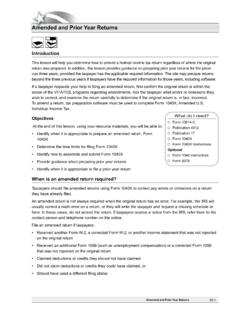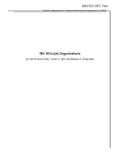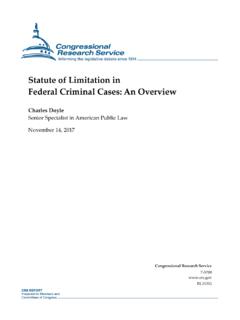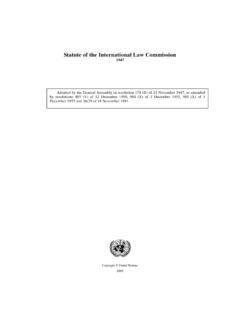Transcription of Medicaid’s Federal Medical Assistance Percentage (FMAP)
1 Medicaid s Federal Medical Assistance Percentage (FMAP) Updated July 29, 2020 Congressional Research Service R43847 Medicaid s Federal Medical Assistance Percentage (FMAP) Congressional Research Service Summary Medicaid is a means-tested entitlement program that finances the delivery of primary and acute Medical services as well as long-term services and supports. Medicaid is jointly funded by the Federal government and the states. The Federal government s share of most Medicaid expenditures is called the Federal Medical Assistance Percentage (FMAP).
2 The remainder is referred to as the state share. Generally determined annually, the FMAP formula is designed so that the Federal government pays a larger portion of Medicaid costs in states with lower per capita incomes relative to the national average (and vice versa for states with higher per capita incomes). FMAP rates have a statutory minimum of 50% and a statutory maximum of 83%. For FY2021, regular FMAP rates range from (13 states) to (Mississippi). The FMAP rate is used to reimburse states for the Federal share of most Medicaid expenditures.
3 However, exceptions to the regular FMAP rate have been made for certain states ( , the District of Columbia and the territories), situations ( , during economic downturns), populations ( , individuals covered by the Patient Protection and Affordable Care Act s [ 111-148, as amended] Medicaid expansion and individuals with breast or cervical cancer), providers ( , Indian Health Service facilities), and services ( , family planning and home health services). In addition, the Federal share for most Medicaid administrative costs does not vary by state and is generally 50%.
4 During the Coronavirus Disease 2019 (COVID-19) public health emergency period, the Family First Coronavirus Response Act (FFCRA; 116-127) provides a increase to the regular FMAP rates for all states, the District of Columbia, and the territories. The FFCRA FMAP increase began on January 1, 2020 (the first day of the calendar quarter in which the COVID-19 public health emergency period began), and the FFCRA FMAP increase is set to end on the last day of the calendar quarter in which COVID-19 public health emergency period ends. To receive the FFCRA FMAP increase, states, the District of Columbia, and the territories are required to meet certain conditions.
5 Such conditions include (1) maintaining Medicaid eligibility standards, methodologies, and procedures that are no more restrictive than what was in effect on January 1, 2020; (2) not imposing premiums exceeding the amounts in place as of January 1, 2020; (3) providing continuous coverage of Medicaid enrollees during the public health emergency period; (4) providing coverage for testing services and treatments for COVID 19; and (5) ensuring local governments are not required to contribute a larger Percentage of the state s nonfederal Medicaid expenditures or Medicaid DSH payments than otherwise would have been required on March 11, 2020.
6 The FFCRA FMAP increase does not apply to most FMAP exceptions. However, the FFCRA FMAP increase does apply to a few FMAP exceptions, such as the FMAP exceptions for the Community First Choice option, individuals eligible on the basis of breast and cervical cancer, Certified Community Behavioral Health Clinics, and Money Follows the Person. The Congressional Budget Office estimates the FFCRA FMAP increase will increase Federal expenditures by about $ billion from FY2020 to FY2022. However, the amount of the increase in Federal expenditures depends on the length of the COVID-19 public health emergency period and states actual expenditures.
7 Medicaid s Federal Medical Assistance Percentage (FMAP) Congressional Research Service Contents Introduction .. 1 The Federal Medical Assistance Percentage .. 1 How FMAP Rates Are Calculated .. 2 Data Used to Calculate State FMAP Rates .. 2 Factors That Affect FMAP 3 FY2021 Regular FMAP Rates .. 4 FMAP 6 Reduction to Regular FMAP Rates .. 12 Territories .. 13 Electronic Visit Verification Systems .. 13 Asset Verification Programs .. 13 FMAP Increase During the COVID-19 Public Health 14 15 Figures Figure 1. State Distribution of Regular FMAP 5 Figure 2.
8 FMAP Rate Changes for States from FY2020 to 6 Tables Table 1. Current Exceptions to the Regular FMAP Rates for Medicaid .. 7 Table A-1. Regular FMAP Rates, by State, FY2016-FY2021 .. 16 Table B-1. Past Exceptions to the Regular FMAP Rates for 18 Appendixes Appendix A. FMAP Rates for Medicaid, by 16 Appendix B. Past FMAP Rate Exceptions .. 18 Contacts Author Information .. 20 Medicaid s Federal Medical Assistance Percentage (FMAP) Congressional Research Service 1 Introduction Medicaid is a means-tested entitlement program that finances the delivery of primary and acute Medical services as well as long-term services and Medicaid is jointly funded by the Federal government and the states.
9 Participation in Medicaid is voluntary for states, though all states, the District of Columbia, and the territories choose to participate. Each state designs and administers its own version of Medicaid under broad Federal rules. While states that choose to participate in Medicaid must comply with all Federal mandated requirements, state variability is the rule rather than the exception in terms of eligibility levels, covered services, and how those services are reimbursed and delivered. The Federal government pays a share of each state s Medicaid This report describes the Federal Medical Assistance Percentage (FMAP) calculation used to reimburse states for most Medicaid expenditures, and it lists the statutory exceptions to the regular FMAP rate.
10 In addition, this report provides a summary of the Family First Coronavirus Response Act (FFCRA; 116-127) FMAP increase that states, the District of Columbia, and the territories are receiving during the Coronavirus Disease 2019 (COVID-19) public health emergency period. The Federal Medical Assistance Percentage The Federal government s share of most Medicaid service costs is determined by the FMAP rate, which varies by state and is determined by a formula set in statute . The FMAP rate is used to reimburse states for the Federal share of most Medicaid expenditures, but exceptions to the regular FMAP rate have been made for certain states, situations, populations, providers, and The FMAP rate also is used to determine the phased-down state contribution ( clawback ) for Medicare Part D and the Federal share of other Federal programs.


















